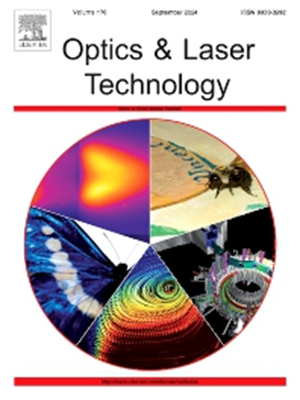Investigation of a thulium-doped fiber laser with bidirectional output assisted by compound ring cavity filter
IF 4.6
2区 物理与天体物理
Q1 OPTICS
引用次数: 0
Abstract
A high-performance bidirectional-output wavelength-switchable narrow-linewidth thulium-doped fiber laser (TDFL) is proposed and has been demonstrated. Based on the uniform fiber Bragg grating for wavelength selection, combined with compound ring cavity (CRC) structure for longitudinal mode selection, single longitudinal mode (SLM) laser operation at wavelengths of ∼2048.502 and ∼1942.080 nm are achieved in clockwise (CW) and counterclockwise (CCW) directions, respectively. The multi-objective optimization algorithms, including multi-objective particle swarm optimization (MOPSO) and non-dominated sorting genetic algorithm Ⅱ (NSGA-Ⅱ), are introduced to achieve a trade-off between suppression ratio (SR) and transmittance while determining multiple CRC parameters. Switching among the three states — CW SLM output, CCW SLM output, and simultaneous bidirectional SLM output in both CW and CCW directions — is achieved based on the optical path transmission characteristics of the circulators and the intracavity loss adjustment mechanism. Spectrum stability, optical signal-to-noise ratio (OSNR), linewidth, relative intensity noise (RIN), and relaxation oscillation peak are all investigated for the three states. The CW and CCW SLM output can generate stable laser output with an OSNR larger than 74.11 dB. The fluctuations of the center wavelength and the peak power are less than 0.01 nm and 1.037 dB, respectively, over 60 min. Linewidth does not exceed 1.93 kHz and the RIN is less than −125.03 dB/Hz at frequencies greater than 2 MHz. The proposed TDFL is expected to be integrated with wavelength-division multiplexing and free-space optical communication systems in the future.
求助全文
约1分钟内获得全文
求助全文
来源期刊
CiteScore
8.50
自引率
10.00%
发文量
1060
审稿时长
3.4 months
期刊介绍:
Optics & Laser Technology aims to provide a vehicle for the publication of a broad range of high quality research and review papers in those fields of scientific and engineering research appertaining to the development and application of the technology of optics and lasers. Papers describing original work in these areas are submitted to rigorous refereeing prior to acceptance for publication.
The scope of Optics & Laser Technology encompasses, but is not restricted to, the following areas:
•development in all types of lasers
•developments in optoelectronic devices and photonics
•developments in new photonics and optical concepts
•developments in conventional optics, optical instruments and components
•techniques of optical metrology, including interferometry and optical fibre sensors
•LIDAR and other non-contact optical measurement techniques, including optical methods in heat and fluid flow
•applications of lasers to materials processing, optical NDT display (including holography) and optical communication
•research and development in the field of laser safety including studies of hazards resulting from the applications of lasers (laser safety, hazards of laser fume)
•developments in optical computing and optical information processing
•developments in new optical materials
•developments in new optical characterization methods and techniques
•developments in quantum optics
•developments in light assisted micro and nanofabrication methods and techniques
•developments in nanophotonics and biophotonics
•developments in imaging processing and systems

 求助内容:
求助内容: 应助结果提醒方式:
应助结果提醒方式:


